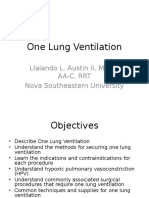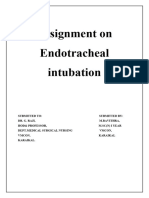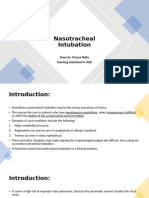Als Procedures
Als Procedures
Uploaded by
api-296884857Copyright:
Available Formats
Als Procedures
Als Procedures
Uploaded by
api-296884857Original Title
Copyright
Available Formats
Share this document
Did you find this document useful?
Is this content inappropriate?
Copyright:
Available Formats
Als Procedures
Als Procedures
Uploaded by
api-296884857Copyright:
Available Formats
ALS PROCEDURES
Oral Endotracheal Intubation
Indications
Patient with decreased sensorium (GCS less than or equal to 8) and apneic (adults)
Patient with decreased sensorium (GCS less than or equal to 8), ventilation unable to be
maintained with BLS airway
Contraindications
Pediatric patients under 40 kg
Suspected hypoglycemia or narcotic overdose
Maxillo-facial trauma with unrecognizable facial landmarks
Patients experiencing seizures
Patients with an active gag reflex
Ventilation should be interrupted for no more than two periods of up to 30 seconds during laryngoscopy
or intubation attempts and patients should be ventilated with 100% oxygen for 1 minute via bag-valve
mask between attempts. No more than two attempts at endotracheal intubation should be done (an
intubation attempt is defined as the laryngoscopy and passing of an ET tube beyond the teeth with the
intent of placing the endotracheal tube). Use of rescue airway or return to BLS maneuvers may occur at
any time (neither require repeated advanced airway attempts before use).
Base hospital physician consultation is recommended if there is any question concerning the need to
intubate a patient. The base hospital physician may also approve extubation of a patient in the field.
Nasotracheal intubation is not an approved skill in Contra Costa County.
Procedure
1) Assure an adequate BLS airway.
2) Oxygenate with 100% oxygen using a bag-valve-mask.
3) Select appropriate ET tube. If appropriate tube has a cuff, check cuff to ensure that it does not
leak; note the amount of air needed to inflate. Deflate tube cuff. Leave syringe attached.
a. Insert appropriate stylet, making sure that it is recessed at least one cm. from the distal
opening of the ET tube. Lubricate the tip of the tube.
b. Prepare endotracheal tube introducer (bougie) and rescue airway for possible use.
4) Assure c-spine immobilization with suspected trauma.
5) Insert laryngoscope and visualize the vocal cords. If unable to identify cords, resume BLS aiway
management and utilize endotracheal tube introducer in next attempt.
6) Suction if necessary and remove any loose or obstructing foreign bodies.
7) CAREFULLY pass the endotracheal tube tip past the vocal cords; remove the stylet ; advance the
ET tube until the cuff is just beyond the vocal cords
8) Inflate the cuff with 5-7ml of air. For uncuffed pediatric tubes, advance tube no more than 2.5 cm
beyond vocal cords (use vocal cord marker line if present on tube).
9) Immediately assess tube placement with capnography or colorimetric end-tidal CO2 indicator
and/or esophageal detector bulb (see tube confirmation procedure):
10) Following successful confirmation of intubation, auscultation of lungs, epigastrium, and
observation of chest rise should be done. If chest does not rise, extubate and reintubate.
Endotracheal tube introducer (bougie) should be considered for second attempt.
11) Secure the tube with tape or ET holder and ventilate. Mark the TUBE at the level of the lips.
Page 30
Contra Costa County Prehospital Care Manual January 2010
Confirmation of Tube Placement / Post-Intubation Monitoring
Every patient intubated with an endotracheal tube or esophageal airway requires initial evaluation
of tube placement and ongoing tube monitoring until patient turnover or until resuscitative
efforts cease.
Physical findings (chest rise, lung and abdominal sounds, and vital signs, if present) must be
assessed and documented in all intubated patients.
End-tidal carbon dioxide (ETCO2) measurement must be utilized in all intubated patients.
Electronic waveform capnography (with numerical ETCO2 readout) should be utilized from the
earliest moment possible after every tube placement to continuously verify placement as well as
to guide ventilation rates. Colorimetric ETCO2 indicators may be useful if electronic monitoring
is not immediately available, but should be replaced with waveform monitoring as soon as
possible.
Documentation of ETCO2 measurement in the patient care record is required in all intubations.
Electronic data upload or attachment of a code summary from the monitor-defibrillator to the
record should be done in all cases.
The esophageal detector bulb is useful only in cardiac arrest situations in which no ETCO2 is
detected, and should only be used with endotracheal tubes (not with King Airway).
When ETCO2 is not detected in the setting of King Airway use, physical exam remains as the key
method to assess functionality of the airway.
Procedure
1) Following tube placement and cuff inflation, attach waveform capnography unit (or colorimetric
ETCO2 indicator if waveform not immediately available).
a.
If exhaled ETCO2 is detected, the tube should be secured. Waveform capnography
should be used continuously until patient turnover or cessation of resuscitative efforts.
Physical exam reassessment should also be utilized after any patient movement.
b. If exhaled ETCO2 is not detected:
1. In a patient with pulses, the tube should be removed and reintubation attempted.
2. In a patient without pulses:
a. Endotracheal tube: use esophageal bulb detector.
b. King Airway: use physical examination findings (chest rise, lung sounds
present, abdominal sounds absent) should be used to verify placement.
c.
Reassessment should occur after any patient movement, and in pulseless patients may
include re-use of the esophageal detector bulb.
d.
In all patients, ETCO2 monitoring should be continued as it may be the initial indicator
when there is return of spontaneous circulation.
Contra Costa County Prehospital Care Manual January 2010
Page 31
SIGNIFICANCE OF END-TIDAL CO2WAVEFORM / CHANGES AFTER INTUBATION
Loss of previous waveform with
Endotracheal tube disconnected, dislodged, kinked or
ETCO2 near zero
obstructed
Loss of circulatory function
Decreasing ETCO2 with loss of
Endotracheal tube cuff leak or deflation
plateau
Endotracheal tube located in hypopharynx
Partial obstruction
Sudden increase in ETCO2
Return of spontaneous circulation
Gradual increase in ETCO2
If elevated above normal levels, need for increased
ventilation
From low levels, improvement in perfusion
Gradual decrease in ETCO2
Effects of hyperventilation
Worsening of perfusion
Sharkfin waveform
Asthma or COPD
Normal capnography:
ET Tube disconnected, displaced, or patient
develops cardiac arrest:
ET Tube in hypopharynx (above cords), partly
obstructed, or cuff leak:
Sudden Increase in ETCO2 (return of
spontaneous circulation):
Shark-Fin waveform (asthma or COPD):
(Source: Medtronic Physio-Control Capnography Educational
Series 2002)
ESOPHAGEAL DETECTOR BULB FINDINGS AND ACTIONS
Finding
Action
Rapid inflation of bulb
Tracheal placement Secure tube
Slow inflation or no inflation
Likely esophageal placement remove tube and reattempt intubation.
If second attempt, remove tube and use King Airway or
BLS airway management
Visualize airway directly via laryngoscopy
Alternative rotate tube 90 degrees, suction, and recheck
with bulb
Remove tube if any question
If paramedic confident of tube
placement (false findings more
common with excessive
secretions, CHF, or obesity)
Page 32
Contra Costa County Prehospital Care Manual January 2010
You might also like
- Oral Physiology ReviewerDocument20 pagesOral Physiology ReviewerCamille Baybay100% (1)
- Anesthesiology Resident Manual of Procedures: A Step-by-Step GuideFrom EverandAnesthesiology Resident Manual of Procedures: A Step-by-Step GuideNo ratings yet
- Prosthodontics Book ListDocument3 pagesProsthodontics Book ListDentist Here100% (1)
- Scheduling of Patients For SurgeryDocument7 pagesScheduling of Patients For SurgeryAllein Antonio-Gegante100% (1)
- Safe SuctioningDocument31 pagesSafe SuctioningKatrina Ponce100% (2)
- One Lung Ventilation: Llalando L. Austin Ii, MHSC, Aa-C, RRT Nova Southeastern UniversityDocument47 pagesOne Lung Ventilation: Llalando L. Austin Ii, MHSC, Aa-C, RRT Nova Southeastern UniversityZulkarnainBustamam100% (1)
- Anes AirwayDocument24 pagesAnes Airwayyana100% (1)
- Monitoring & Care of Ventilated ChildrenDocument12 pagesMonitoring & Care of Ventilated ChildrenRajakumar Padur Sivaraman100% (2)
- Extubation After Difficult IntubationDocument3 pagesExtubation After Difficult Intubationramanrajesh83No ratings yet
- Endotracheal TubeDocument19 pagesEndotracheal TubeSarvess Muniandy100% (1)
- General Anesthesia: IntubationDocument44 pagesGeneral Anesthesia: IntubationMiezu CosminNo ratings yet
- CH 2 SuctioningDocument90 pagesCH 2 SuctioningMaherNo ratings yet
- Et IntubationDocument3 pagesEt IntubationCherry L. M. JaramilloNo ratings yet
- SuctioningDocument37 pagesSuctioningizzati.hafiza11No ratings yet
- NGT Peritoneal LavageDocument12 pagesNGT Peritoneal LavageJeffrey Dela CruzNo ratings yet
- Airway ManagementDocument50 pagesAirway ManagementEmman AbelardoNo ratings yet
- 9 - ACLS - Part 1Document50 pages9 - ACLS - Part 1Mohnmad ZaitoonNo ratings yet
- Rapid Sequence Intubation: BY Budak KecikDocument25 pagesRapid Sequence Intubation: BY Budak KecikAqua ForceNo ratings yet
- Suction Endotracheal V P StgeorgeDocument3 pagesSuction Endotracheal V P StgeorgeElaine Iris AbastaNo ratings yet
- Approach in Trauma Patient - OrthopaedicDocument91 pagesApproach in Trauma Patient - OrthopaedicBesi Tua100% (1)
- Airwaymanagement 090810125917 Phpapp02Document41 pagesAirwaymanagement 090810125917 Phpapp02AzanReza AbdullehNo ratings yet
- Dvanced Nursing ProceduresDocument125 pagesDvanced Nursing Procedurestum chrisNo ratings yet
- Airway ClearanceDocument24 pagesAirway ClearanceGoddy ManzanoNo ratings yet
- Intro To Specialized Nursing ProceduresDocument156 pagesIntro To Specialized Nursing ProceduresJimmy MainaNo ratings yet
- Endotracheal Intubation AssignmentDocument16 pagesEndotracheal Intubation AssignmentBavi ThraNo ratings yet
- Neonatal IntubationDocument7 pagesNeonatal Intubationdrsalil82No ratings yet
- Assissting IntubationDocument17 pagesAssissting IntubationTriciaNo ratings yet
- Endotracheal Intubation & ER Board Exam QuestionsDocument33 pagesEndotracheal Intubation & ER Board Exam QuestionsJo-Anne Karen Serdeña0% (1)
- Airway Management - IntubationDocument31 pagesAirway Management - IntubationRajaNo ratings yet
- Principles and Practice of GI EndosDocument101 pagesPrinciples and Practice of GI Endosrajan kumar90% (21)
- Tracheostomy Care and SuctioningDocument45 pagesTracheostomy Care and SuctioningNursing NotesNo ratings yet
- UVC NewbornDocument6 pagesUVC NewbornMani VachaganNo ratings yet
- Airway Management LectureDocument113 pagesAirway Management LectureAnita Krisnawaty NainggolanNo ratings yet
- Tracheostomy: ENT Department DMC & Hospital Ludhiana PunjabDocument46 pagesTracheostomy: ENT Department DMC & Hospital Ludhiana PunjabVikrant MittalNo ratings yet
- Airway Instruments: Dr. Amr Marzouk Mohamed Assistant Lecturer of AnesthesiaDocument41 pagesAirway Instruments: Dr. Amr Marzouk Mohamed Assistant Lecturer of AnesthesiaArtha PutuNo ratings yet
- 79 Endotracheal IntubationDocument1 page79 Endotracheal IntubationAdria Putra FarhandikaNo ratings yet
- Video Laryngoscopy and Fiberoptic Assisted Tracheal IntubationDocument108 pagesVideo Laryngoscopy and Fiberoptic Assisted Tracheal IntubationAlisher AgzamovNo ratings yet
- Airway Management For ParamedicsDocument53 pagesAirway Management For ParamedicsNataliya PiletskaNo ratings yet
- SPH CT ProtocolDocument13 pagesSPH CT ProtocolRahel GrunderNo ratings yet
- 02 CPP AirwayDocument21 pages02 CPP AirwayNia WahyuniNo ratings yet
- 2978-Minimally Invasive Surgery-Singh-Minimally Invasive Lung - EngDocument3 pages2978-Minimally Invasive Surgery-Singh-Minimally Invasive Lung - EngSilvia RoseNo ratings yet
- One Lung VentilationDocument38 pagesOne Lung VentilationVarun Reddy V100% (1)
- ATLS TemplateDocument6 pagesATLS Templatesyasya100% (2)
- Cusp Meeting PowerpointDocument15 pagesCusp Meeting Powerpointapi-263387400No ratings yet
- Care of The Clients With Respiratory DisordersDocument10 pagesCare of The Clients With Respiratory Disordersdexter100% (3)
- Difficult Airway ManagementDocument79 pagesDifficult Airway Managementedwardjohnson2310No ratings yet
- Artificial AirwayDocument3 pagesArtificial AirwayKusum RoyNo ratings yet
- First Two Steps Are Discussed in This SectionDocument26 pagesFirst Two Steps Are Discussed in This SectionArchanaShenoyNo ratings yet
- 3.nasotracheal IntubationDocument12 pages3.nasotracheal Intubationm4mv5zrfccNo ratings yet
- Tracheostomy: Berlian Chevi A. 20184010030Document26 pagesTracheostomy: Berlian Chevi A. 20184010030Berlian Chevi e'Xgepz ThrearsansNo ratings yet
- SuctioningDocument28 pagesSuctioningRalph Emerson RatonNo ratings yet
- SuctioningDocument17 pagesSuctioningKandi Issaya100% (2)
- Computed Tomography (CT) and Magnetic Resonance Imaging (MRI)Document12 pagesComputed Tomography (CT) and Magnetic Resonance Imaging (MRI)jgcriste100% (9)
- Assisting in Endotracheal SuctioningDocument38 pagesAssisting in Endotracheal SuctioningMargarita Limon BalunesNo ratings yet
- Nasogastric Feeding TubeDocument7 pagesNasogastric Feeding Tubepatrayati90No ratings yet
- 3.nasotracheal IntubationDocument12 pages3.nasotracheal Intubationm4mv5zrfccNo ratings yet
- Broncho SDocument3 pagesBroncho Sja30jd15ve15an22No ratings yet
- Anaesthesia For Tonsillectomy TOTW 051 2007 230316 022350Document10 pagesAnaesthesia For Tonsillectomy TOTW 051 2007 230316 022350Srihari JanakiNo ratings yet
- 145 One Lung VentilationDocument6 pages145 One Lung VentilationEyad AbdeljawadNo ratings yet
- Diagnostic Evaluation in Respiratory Conditions-1Document68 pagesDiagnostic Evaluation in Respiratory Conditions-1pashiem88No ratings yet
- DRILLINGDocument3 pagesDRILLING4gen_5No ratings yet
- Percutaneous Emergency Oxygenation Strategies in the “Can’t Intubate, Can’t Oxygenate” Scenario: PEOS in the CICO Scenario, #2From EverandPercutaneous Emergency Oxygenation Strategies in the “Can’t Intubate, Can’t Oxygenate” Scenario: PEOS in the CICO Scenario, #2No ratings yet
- InviteDocument2 pagesInviteapi-296884857No ratings yet
- GG InterviewDocument2 pagesGG Interviewapi-296884857No ratings yet
- Ism-Interview Assignment Questions: Printed Name of Person Interviewed: Role of IndividualDocument4 pagesIsm-Interview Assignment Questions: Printed Name of Person Interviewed: Role of Individualapi-296884857No ratings yet
- Dawn InterviewDocument2 pagesDawn Interviewapi-296884857No ratings yet
- Legal Briefs 0289 p006Document3 pagesLegal Briefs 0289 p006api-296884857No ratings yet
- Brochure IsmDocument2 pagesBrochure Ismapi-296884857No ratings yet
- Ivq FDLDocument2 pagesIvq FDLapi-296884857No ratings yet
- Cs 2Document1 pageCs 2api-296884857No ratings yet
- Case Study: Caucasian Female - 30 Years OldDocument1 pageCase Study: Caucasian Female - 30 Years Oldapi-296884857No ratings yet
- Post DeliveryDocument26 pagesPost DeliverySaid Said (ابو خالد)No ratings yet
- Colonic & Rectal Lavage ProcedureDocument2 pagesColonic & Rectal Lavage Procedurejoel david knda mjNo ratings yet
- GREAT SupremeHealth and GREAT TotalCare Brochure (Full) Version 3 - 2022Document22 pagesGREAT SupremeHealth and GREAT TotalCare Brochure (Full) Version 3 - 2022Wenwei ChionhNo ratings yet
- Standards of Soft Tissue Arnett Analysis For Surgical Planning in Turkish AdultsDocument8 pagesStandards of Soft Tissue Arnett Analysis For Surgical Planning in Turkish AdultsŞükriye AngaNo ratings yet
- 2023 Complications and Treatment Errors in Peri-Implant Hard Tissue ManagementDocument22 pages2023 Complications and Treatment Errors in Peri-Implant Hard Tissue Managementmatias cofreNo ratings yet
- Case Study - CVDDocument2 pagesCase Study - CVDJenny JendersNo ratings yet
- Fundamentalof Ventilation & PacemakerDocument22 pagesFundamentalof Ventilation & PacemakerLucila Lugo100% (1)
- The Aetiology, Diagnosis and Management of Mandibular AsymmetryDocument9 pagesThe Aetiology, Diagnosis and Management of Mandibular AsymmetryKaram EidNo ratings yet
- Appendectomy InstrumentsDocument47 pagesAppendectomy InstrumentsmoqtadirNo ratings yet
- Managemen Disritmia: Dr. Rofika Hanifa, SPPDDocument20 pagesManagemen Disritmia: Dr. Rofika Hanifa, SPPDavivlabirdNo ratings yet
- Teknik Anestesi UmumDocument128 pagesTeknik Anestesi UmumRiezka HanafiahNo ratings yet
- Ultrasound Assessment of Gastric Content and VolumeDocument8 pagesUltrasound Assessment of Gastric Content and VolumeeryxspNo ratings yet
- Short Hand Book of UltrasoundDocument106 pagesShort Hand Book of Ultrasoundjnracquahxhamiel100% (5)
- Bladder TraumaDocument13 pagesBladder TraumaAnusikta PandaNo ratings yet
- Open Book FractureDocument31 pagesOpen Book FractureMUHAMMAD ADLI ADNAN BIN JAMIL STUDENTNo ratings yet
- GIT ChecklistDocument3 pagesGIT Checklisthak jsoNo ratings yet
- Implant Surgical Guides From The Past To The PresentDocument6 pagesImplant Surgical Guides From The Past To The Presentwaf51No ratings yet
- Risk For Decreased Cardiac Tissue PerfusionDocument3 pagesRisk For Decreased Cardiac Tissue PerfusionKarina MadriagaNo ratings yet
- Course 5 Pleuro-Pulmonary Surgical SemiologyDocument23 pagesCourse 5 Pleuro-Pulmonary Surgical SemiologyvladutNo ratings yet
- Midodrine To Optimize Heart Failure Therapy in Patients With Concurrent HypotensionDocument5 pagesMidodrine To Optimize Heart Failure Therapy in Patients With Concurrent HypotensionAyi PuspitasariNo ratings yet
- COVERT Risk Factor For Submucosal Invasion in LST Bourke 2019Document12 pagesCOVERT Risk Factor For Submucosal Invasion in LST Bourke 2019Bryan MedinaNo ratings yet
- Hernia & Testis MCQsDocument8 pagesHernia & Testis MCQsRawan WaleedNo ratings yet
- Suturing WorkshopDocument87 pagesSuturing WorkshopVictor OpreaNo ratings yet
- Chapter 07a - Axial SkeletonDocument66 pagesChapter 07a - Axial Skeletoncccarrot.carrot3No ratings yet
- Surgitron Man EnglDocument8 pagesSurgitron Man EnglFernando CharryNo ratings yet
- Simplification of Referral System Under CGHS (Jan 2018) PDFDocument3 pagesSimplification of Referral System Under CGHS (Jan 2018) PDFsasasjkNo ratings yet
- Testicular Trauma: Dr. Mutuku W. RDocument28 pagesTesticular Trauma: Dr. Mutuku W. RWanza Rachel100% (1)


































































































